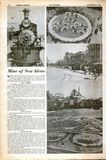
MICKEY MOUSE built a better man-trap and as many as 160,000 people in a week have beaten a pathway to Disneyland's door. The "magic kingdom" of Walt Disney, whose cartoon character creations are better known to most kids than soap, amply displays the result of 20 years' planning – and dreaming.
Costs $17,000,000
The "kiddieland for adults," as Disney chooses to describe it, has sparked much new thinking among fair executives and amusement park operators, and the results of this new thinking are expected to e show up on many fairgrounds and amusement parks in the years ahead.
Disneyland, which costs $17,000,000 when it opened July 18, started fabulously in June, 1953, when Disney retained' the Stanford Research Institute under the direction of C. V. Wood Jr. to survey different sites for the 160-acre park. After the survey was completed Wood was assigned by Disney to act as vice-president and general manager of Disneyland, Inc., to continue with actual construction and organization.
Selection of the Anaheim, Calif., site was made from among many after a year's study in location analysis and a complete search of land records. Among other qualifications, utility conditions, accessibility, topography and environmental characteristics were considered. Even annual rainfall figures helped in making the final decision. The Institute also conducted a complete economic feasibility study of the entire Disneyland operation. This included a thoro survey of attendance patterns for amusement areas and the projection of an annual rate of operation for Disneyland.
Built to 5/8 Scale
The park is constructed on 5/8 scale, necessitating special materials from mills.
The Disney kingdom is divided into four parts – Tomorrowland, Frontierland, Adventureland and Fantasyland.
The scheme followed in the various divisions is in keeping with their titles. Tomorrowland features equipment to fit the future. The chairs, benches and accessories are the product of inventors' imagination as what will be used in the future. Frontierland is enhanced by gnarled pine posts picked up by Disney on a trip to the Jackson Hole country in Wyoming. And a feature is the 105-foot paddle-wheeling river boat, Mark Twain. Adventureland is tropical in design with trees from Australia, South Africa, China and Japan. Plastic life-like "animals" are electrically operated and mechanisms open the jaws of rhinos and other jungle beasts.
Re-Design Basic Rides
Fantasyland, the amusement ride section, brought new types of devices into the field. Some bear a small basic resemblance to the conventional rides. A Merry-Go-Round purchased from J. W. (Patty) Conklin arrived in the United States with the two outside rows of horses as jumpers and the inside one stationary. The stationary one was converted to jumpers and another jumper row added to make it a four-abreast. The Arrow Development Company in Mountain View, Calif., worked overtime to complete its contract of over $100,000 for making new rides designed by Disney and refinishing others. The basic work on the Mr. Toad cars was done in the Arrow shops along with building the Tea Cup Ride, portions of the Casey Jr. train, and the working section of Dumbo.
Disneyland will never be completed in the sense that Disney will sit back and consider all has been done. To offer something new and to keep the magic kingdom more alluring, Disney will do more and more dreaming and planning. That's what makes it Disneyland.